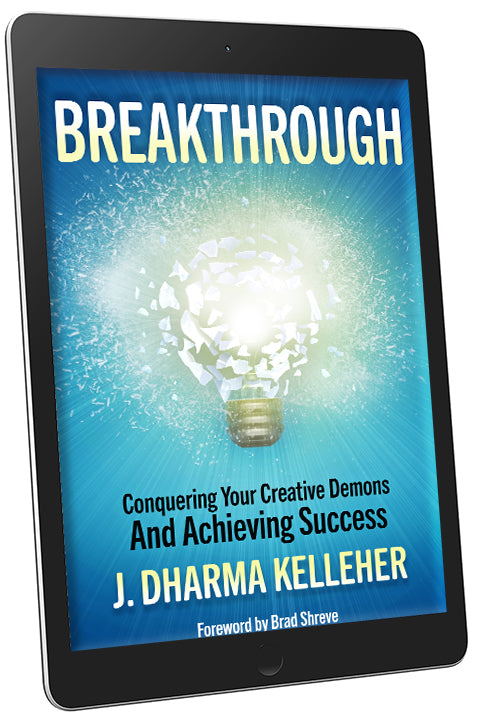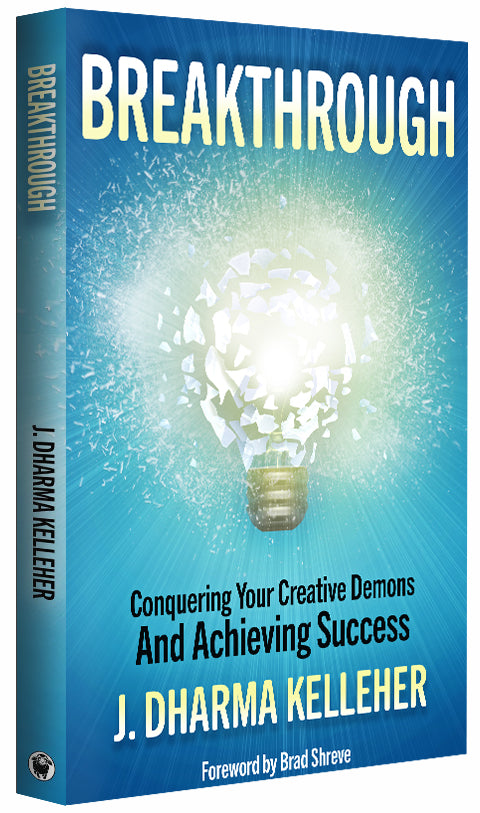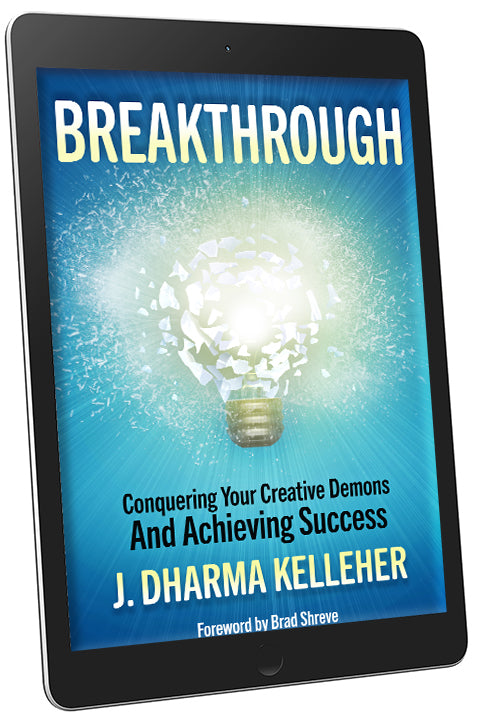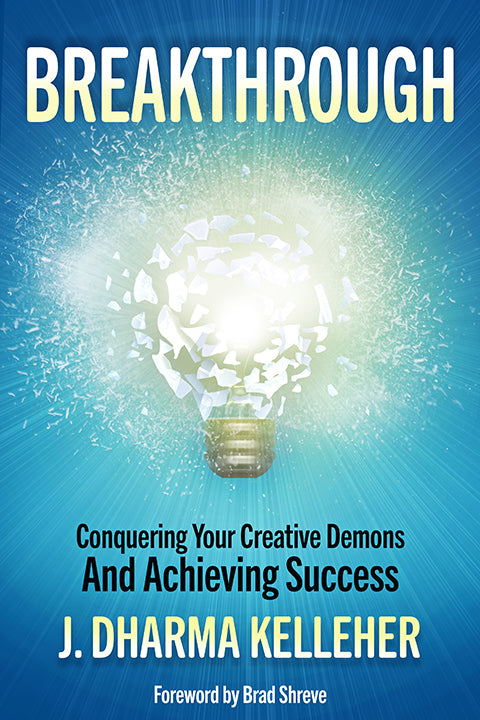Breakthrough
Breakthrough
Genre: Self-help & personal development
Couldn't load pickup availability




Collapsible content
Synopsis
Don't let self-doubt sabotage your author career
Breakthrough: Conquering Your Creative Demons and Achieving Success is the must-read guide for every writer struggling with imposter syndrome, writer's block, and creative self-doubt. Written by experienced crime novelist Dharma Kelleher, this powerful book will help you confront your fears and insecurities, and put you on the path to a more fulfilling and successful writing career.
In Breakthrough, Dharma shares her own personal journey of overcoming substance abuse, PTSD, and the self-doubt that often plagues writers. Drawing on her years as a practicing Buddhist, she provides deep insights and practical steps to help you build a strong mindset, increase your confidence, and push through your limits.
Focusing on mindset, not craft, this book will equip you with the tools you need to write with greater ease, joy, and success. Whether you're struggling to get started, feeling overwhelmed by the creative process, or simply seeking a more positive and fulfilling writing journey, Breakthrough has the answers you've been looking for.
You deserve to love your work, to be proud of your creations, and to enjoy the journey every step of the way. Get ready to breakthrough and become the writer you've always wanted to be!
So why wait? Buy your copy of Breakthrough today and start your journey towards emotional and financial success as a writer.
Read Chapter 1 Now
Before we start exploring the solutions, we must understand the problem that we are dealing with. Imposter syndrome and writer’s block may seem like different issues, but they are different expressions of the same issue: creative self-doubt.
What is creative self-doubt? At its most basic, creative self-doubt is fear. Fear of the uncertainty that is inherent in creativity. Fear of failure. Fear of success. Fear of acting without permission. Fear of change. Fear of staying the same. Fear of getting stuck. Fear of moving ahead into parts unknown.
Creative self-doubt is that voice in our brain that tells us that our creative works are crap, that we have no talent, or that we are a fraud in danger of being found out and punished. It tells us not to bother trying, because whatever we put on the page will be embarrassingly awful and unfixable.
Even if we knocked it out of the park with a previous project, this voice of doom insists that success was a fluke. We don’t have any more good ideas. We don’t have real talent. We don’t have the proper education or training to make it as a creative.
Creative self-doubt tells us that no matter how much success we may experience, no matter how many awards or glowing reviews we may receive, our creative works are disappointingly subpar. And when the rest of the world realizes how awful our work really is, there will be hell to pay. They will rip us to shreds, stripping us of any awards and the right to call ourselves authors, much less bestsellers. No one will ever buy our work again. We might as well quit now.
Sound familiar? If so, you’re not alone. And you’re in the right place.
Creative people across all forms of media struggle with this nagging voice that persists in telling us we’re not good enough. We don’t have what it takes.
Even super-successful artists and writers have struggled with this. Whether you call it imposter syndrome or comparisonitis or writer’s block or simply insecurity, it’s ubiquitous in the creative world. There’s always someone better, and by comparison, our work feels like a pathetic joke.
We struggle with weaponized terms like “real author” or “real artist.” Who gets to decide what “real” is?
In the movie The Matrix, Morpheus asks Neo, “What is real? How do you define ‘real’? If you’re talking about what you can feel, what you can smell, what you can taste and see, then ‘real’ is simply electrical signals interpreted by your brain.”
In the context of our creative work, “real” doesn’t have any substantive meaning. It’s nothing more than gaslighting, a delusion.
If you write, you are a writer. If you have finished a story, whether or not it’s been published, you are an author. Period. “Real” is merely a weapon our insecurity uses against us to keep us from creating and trying new things.
Why do we have this self-doubt? Where does it come from? Some of us received unduly harsh criticism from a teacher or mentor who should have encouraged us. Maybe some of us were born this way. I’ve struggled with insecurity as far back as I can remember.
Part of what makes self-doubt so pervasive is the uncertainty. Every time we write a story, we are creating something new. We’re not making widgets, each one the same as the last. With every story, we are creating new characters, new adventures, and new worlds. Even within a series, we are taking our existing characters and pushing them further than we have before. We are presenting them and thus ourselves with new challenges.
With each new story, we are taking a chance that our words may not resonate the way we would like. Even if our last story garnered glowing reviews, there is no guarantee the next one will. We are always treading new ground and facing new risks. With so much on the line, so many unknowns, self-doubt is inevitable.
But self-doubt doesn’t have to control us or rob us of the joy of creation. We can retrain that part of our minds to work with us rather than against us. We can grow so that when we look back on our work, we can treasure it for what it is without embarrassment. We can go through our rough drafts or early efforts without stabbing our souls with hateful thoughts. We can carve doors in the seemingly impenetrable creative block and find a way through.
We can even explore new avenues in our chosen craft, or look into learning new crafts without the unbearable sense of doom and hopelessness. If you’re a writer, maybe you will experiment with other genres. If you’re an artist, perhaps you will try out new media.
The blank page or canvas or block of stone or new role will no longer seem the threatening cave of impossibilities or overwhelm you.
But I want to make one thing very clear. This isn’t a simple fix. There is no affirmation or meditation that will make your creative self-doubt vanish overnight. Rather, we are unlearning years of negativity. We are shaving away at its power one micro-thin layer at a time. Give the tools time to work.
As I mentioned in the introduction, I struggled with self-doubt since early childhood. The voices of negativity have not completely vanished from my mind. But they no longer hold sway as they once did. Discovering a flaw in a story doesn’t feel like a stake to the heart, sending me spiraling down a well of worthlessness. It’s simply something that needs to be fixed.
This is a journey of recovery. It is a quest to rediscover our joy in our chosen craft. It is an adventure to slay our own dragons, or at the very least train them to follow our commands.
Are you ready to join me?
Let’s start with the different voices inside your head. I’m not talking about the voices of your characters but rather the different voices that show up when it’s time to work on your writing.
First, there is the creative voice, what some call their muse. That voice is you. It has been with you since childhood. It was what inspired you to write. The creative voice likes to play “What if?” It likes to imagine new characters, worlds, stories, and plot twists.
What if there was a bounty hunter who was transgender and who enjoyed cosplaying as Wonder Woman? What if there was an international spy that suddenly developed OCD after being tortured by the enemy? What if there was a tattoo artist who discovered a bag full of money next to her boyfriend’s dead body? What if a man develops a crush on a woman he met at the supermarket, but he assumes she’s dating someone because he misheard a phone conversation?
Our creative voice doesn’t worry about info dumps or spelling or comma splices or POV shifts or plot holes. This voice is in love with the thrill of inventing stories and putting them on paper. This is the voice that’s in charge when we’re creating a story outline and our rough draft. This voice is playful and loves to experiment.
Next comes our editorial voice or inner editor. This aspect of our mind supports our creative voice. Our editorial voice doesn’t seek to tear apart what the creative voice has created. It takes what the creative voice has laid down and makes it better. The editorial voice is a mensch, a fixer, a polisher.
This inner editor sees an info dump and asks, “What details in this info dump do I need to keep, and what is pulling the reader out of the story?”
When the editor recognizes awkward dialogue, it asks, “How can I reword this so that the language flows more naturally and keeps the reader engaged?” There’s no shaming. No humiliation. The editorial voice is simply seeking to improve what’s already there.
The creative voice and the editorial voice are on the same team. Their goal is the same—to tell the best story you can. Because they are both you. You want to tell the best story you can.
Sometimes the editorial voice jumps in too soon, such as when the creative voice is writing the rough draft or the outline. When this happens, it can gum up the works. We can get so focused on proper structure, grammar, spelling, and factual details that our creative voice gets overwhelmed. Our muse packs up her bat and ball and goes home.
When this happens, we have to remind our editorial voice to wait their turn. First, we create, then we fix. Whatever mistakes we make in our rough draft we can rectify later.
And when you revise, don’t leave your muse locked in the closet, bound and gagged. Let her out because sometimes, she comes up with better ideas than she did the first go-round. Not only can this help you tell a better story, but it can make the revision process a little more playful and fun. Let your muse and editor work together when the time is right.
Besides the muse and the editor, there is often an all-too-familiar third voice—the shaming voice. I like to call it the troll. The troll isn’t a team player. It doesn’t get along with either the muse or the editor. It isn’t seeking to improve your story. The troll wants to crap on everything you’ve worked so hard on, or better yet, to keep you from writing anything in the first place.
The troll or shaming voice likes to pretend it’s your editorial voice. But its goal isn’t to make your work better. It just wants to stifle creativity and leave you feeling badly about yourself as an author and about everything you’ve written.
Where the editorial voice might ask, “How can I make this scene more engaging?” the troll just states, “This is crap. It’s boring. The characters are milquetoast. The world isn’t believable. No one will want to read this.”
Like the creative voice and the editorial voice, the shaming voice is a part of us. It’s not a bad part of us. It’s where we are wounded. It’s where we are afraid to fail or even afraid to succeed. It is the embodiment of our creative self-doubt. And if we want to grow on our author journey, we will need to learn how to handle the little troll inside of us so that it doesn’t control either our creative or editorial process.
By freeing ourselves from this negative, shaming voice, we can not only write better stories but appreciate all the work we put into them. We can reread them years later and be proud of our efforts. We will no longer feel the need to cringe when someone compliments our work. We will no longer feel like an imposter when our work receives the recognition it deserves. We can enjoy and celebrate all aspects of our writing journey.
That is the goal of this book. I am providing you with basic tools that will help you take back control of your creative process and free yourself from the troll’s shaming and fearmongering. I will also explore scenarios in which creative self-doubt can arise in your author journey and how to work through these situations.
Welcome to your breakthrough.
When And How You'll Receive Your Book
Ebooks: Ebooks are delivered via Bookfunnel. You will receive an email with a link to download your book(s) onto your ebook device or app.
If you run into any problems, click on the Help link on the Bookfunnel page. They are experts in helping people get their content onto their device or app.
Audiobooks: As with ebooks, audiobooks are delivered via Bookfunnel. You will receive an email with a link to add your audiobook to your BookFunnel library and listen on your device.
If you run into any problems, click on the Help link on the Bookfunnel page. They are experts in helping people get their content onto their device or app.
Signed Print Books (US. only): I personally sign and mail print books via USPS Media Mail. I usually fulfill the order within a day or so, and it usually arrives within a week.
Page Count and Other Details
- Pages: 210
- Print size: 5.5"x8.5"




